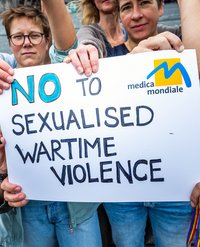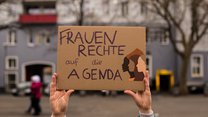Sexualised violence
There are many forms of sexualised violence. The common feature is that a sexual act is carried out against the will of a person and contrary to their right of self-determination. Even non-physical acts such as sexual insults count as sexualised violence, as does sexual harassment in the form of uninvited kissing or touching. Further forms of sexualised violence include: rape, stalking, sexual slavery, forced prostitution, forced sexual or pornographic acts, forced pregnancy, genital mutilation, forced abortion, compulsory sterilisation and forced marriage.
Sexualised violence is generally carried out by male perpetrators against women and girls. In rarer cases boys and men are victims of female perpetrators. Those affected include people of every religion, every nationality, every social level, and every sexual orientation. The risk of becoming a victim of sexualised violence increases as soon as there are no protective, sanctioning laws – or no effective enforcement of these. It also increases in situations of dependence, such as during refugees’ flight and in refugee accommodation.
Sexualised violence is a particularly stubborn feature of our societies – whether during wartime, in post-war society or in times of peace. This constant feature is a product of our society, mirroring misogynist attitudes. However, change can be achieved, in particular by means of awareness-raising work, gender-equal upbringing of children, targeted professional training (especially for staff in the healthcare, police, judicial and care sectors), a zero-tolerance policy against violence, suitable laws and appropriate enforcement of the law.
‘Sexualised’ violence, and not ‘sexual’ violence
medica mondiale chooses to use the term ‘sexualised violence’ instead of ‘sexual violence’. The purpose here is to make clear that the intention behind the act of violence is not primarily the satisfaction of sexual desire but rather the exercise of power, control and oppression. In her working paper “War and Rape: Approaches to Analysis", the social scientist Dr Ruth Seifert asks us to note that rape is not an aggressive expression of sexuality, but rather a sexual expression of aggression: i.e. the violence is sexualised. Sexualised violence is a severe human rights crime.
Study shows: Perpetrators mostly relatives or acquaintances
According to a 2002-2004 study by the German Federal Ministry of Family Affairs, Senior Citizens, Women and Youth, 13 per cent of the 10,000 surveyed women had experienced sexual violence in a form punishable by law since they were 16 years old. That is almost one woman in seven in Germany.
Of the women in the survey who had survived rape or sexual coercion, only 15 per cent did not know the perpetrator. Most of the perpetrators were their own (ex-)partners or someone they knew or were related to. According to the study, the proportion of suspects from the survivors’ wider family has increased. One reason for this increase in suspects from the family surroundings is an increased readiness to actually report these crimes, due in part to the new statutory offence from 1998 which declared rape within marriage to be a crime. Rape and sexual coercion or assault are not restricted to certain social classes: according to the Ministry study, sexualised violence occurs independently of formal education or income levels.







